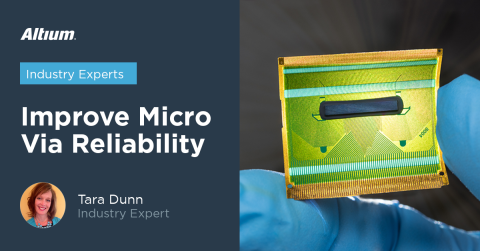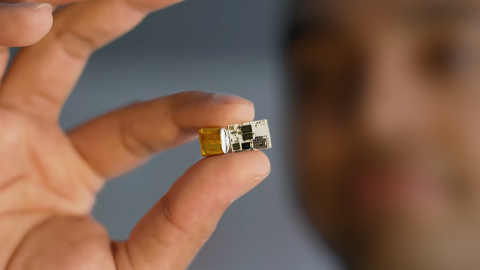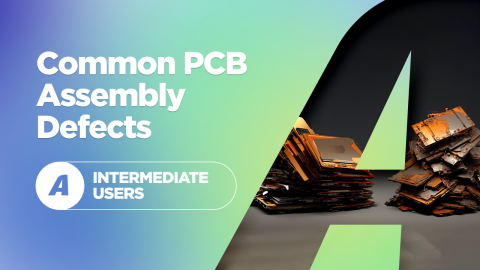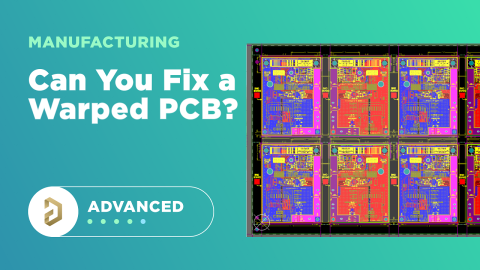Best Design Practices for Double-Sided PCB Reflow Soldering with SMD Parts

DFM guidelines tend to focus on fabrication, but we can't forget that assembly is the critical step that turns a sheet of composite material into a real electronic device. That means DFA is in full effect for single-sided and double-sided PCBs. Like other manufacturing defects, there are some steps a designer can take to ensure their double-sided PCBA will have high yield. Here’s what you can do to ensure high yield after double-sided PCB soldering.
The Double-Sided PCB Soldering Process
For double-sided PCBs with SMD components, the board will need to go through sequential reflow soldering unless you opt for hand assembly. Reflow soldering will be used on high volume runs/low-cost prototyping runs, so designers should plan for reflow soldering during assembly. In the double-sided PCB soldering process, components are placed and soldered on each side of the board individually. The trick here is to solder at just the right temperature and time as the components on the first side will be going through reflow soldering twice.
During this process, some defects can occur on double-sided PCBs. The principal defect is warpage, while the secondary defect is a weak or failed solder joint. Applying the process to a double-sided board does not necessarily require special equipment, but running the process twice puts the PCBA at risk of experiencing defects. There are some basic steps designers and assemblers have to take with double-sided boards to prevent these defects:
Consider a Higher Tg Substrate
Using a substrate with higher glass transition temperature Tg will help prevent warping during repeated reflow passes simply because the board will experience less expansion than a low Tg substrate. The Tg value for standard FR4 substrates is about 130 °C for substrates classified as “low Tg,” or greater than about 170 °C for substrates classified as “high Tg.” This is below the typical peak reflow temperature for Pb-free (Sn/Ag) solder, which can reach 240-250 °C. Therefore, opt for a higher Tg substrate to help prevent warpage during double-sided PCB soldering.
As always, you can check with your manufacturer to ensure they can meet warpage specs if a lower Tg substrate is used in repeated reflow passes.
Double-Sided BGA Soldering
What about soldering BGAs on both sides of the board? Multiple large BGA packages are not so common, but micro BGA packages are becoming more common and are a popular option for small components. Just like other SMD components, you can place them on both sides of a board for a double-sided PCB reflow soldering process. The question is then, how can you design the board to ensure the highest possible assembly yield and ensure performance?
There are two approaches to take with BGAs, which are shown below:

Overlapping BGAs: The ideal method from a placement and fixation standpoint in assembly is for the designer to place these as a mirror image, where identical packages are placed directly behind each other (think of a RAM stick). In the case where packages are mismatched, the component arrangement will also be mismatched. The preferred order would be to place the smaller, lighter BGA packages, as well as smaller SMD components, on one side of the board and solder these first. Then place the larger BGA on the opposite side and send it through reflow second. This way, the lighter parts will have lower chance of desoldering or empty/false welding during the second pass.
In practical terms, or just in terms of the needs of each package, directly overlapping BGAs in this way is not always possible. There are several reasons for this:
- It almost always requires HDI builds with blind/buried vias
- Depending on pin count and density, it could require many more layers than would be necessary with offset placement
- Not all BGAs have identical packaging, weight, or dimensions
- It is not possible with large processors that demand capacitors placed on the back side
The last point is most important for large digital processors, which will often demand placement of capacitors behind the BGA for power integrity purposes. These processors can also dominate the determination of the layer count, especially when they have the highest pin counts compared to all other parts (often in the 100's of pins). For example, take a look the capacitors with via-in-pad on the back side of a BGA in the image below. These capacitors are necessary to ensure power integrity in a large digital processor, and the placement ensures minimal inductance along te current path.

Offset BGAs: At the end of the day, only some BGAs can be placed in a mirror image format on opposite sides, all others will need to be offset. From a practical standpoint, this is also not perfectly easy to implement because most packages will not have the same weight/dimensions. In this case, the best reflow order may be one where the smaller, lighter packages are placed together on one side of the board and reflowed first, and lone large packages placed on the other side and reflowed second.
Expect Heavier Parts to be Soldered by Hand
Heavier parts, such as a transformer or bulky connector, should be hand soldered or processed with selective soldering as it’s difficult to counterbalance their weight across the board. In general, a PCB designer will not naturally be placing those parts such that they are evenly distributed with weight balanced across the board surface, so an assembler will have to accommodate this on single or double-sided PCB. Consider having these parts placed and/or soldered by hand to prevent warpage and ensure high yield.
Reflow Profile Based on Board Design
Next is the question of the reflow profile on each side. How should the reflow profiles be constructed? Should they be the same on both sides of the board? There isn’t a firm answer to this question as it depends on the components being soldered and what is the surface plating on exposed conductors. The surface plating is particularly important as intermetallics can form during soldering:
- Exposed copper: Tin in the solder alloy can form Cu-Sn intermetallics, which slowly grow and eventually become brittle during soldering. Reduce the overall time at higher temperatures by getting up to the peak reflow temperature quickly.
- Electroplated nickel and electroless nickel: The intermetallic alloy Ni3Sn4 most commonly forms during soldering with tin-based solders, although the formation rate is much lower than Cu-Sn intermetallics.
- ENIG, ENEPIG, OSP, and immersion Ag: Cu-Sn/Ag intermetallics can form on these platings at the interface, rather than diffusing into the bulk. Interestingly, the Ni layer inside of ENIG and ENEPIG has a toughening effect on some intermetallics, which prevents crack formation.
Without going much further into the chemistry, the important takeaway here is that the reflow profile for a double-sided PCB should be designed to accommodate various PCB surface platings for double-sided boards. There are some interesting studies that look at the formation rate of different intermetallics, and these can provide some guidance for comparing reference reflow profiles. Here are two great references where you can learn more:
- Aisha, I. Siti Rabiatull, et al. "Effect of reflow profile on intermetallic compound formation." In IOP Conference Series: Materials Science and Engineering, vol. 46, no. 1, p. 012037. IOP Publishing, 2013.
- Guoyuan, et al. "Effects of surface finishes on the intermetallic growth and micro-structure evolution of the Sn3. 5Ag0. 7Cu lead-free solder joints." In 2009 International Conference on Electronic Packaging Technology & High Density Packaging, pp. 807-811. IEEE, 2009.
If you’re designing a new product that will require double-sided PCB soldering, use the complete set of PCB design and layout tools in Altium Designer® to create your board and prepare for manufacturing. The Layer Stackup Manager and upgraded Design Rules Editor help you create a high-quality board that complies with DFM/DFA standards for double-sided PCBs.
When you’ve finished your design, and you want to share your project, the Altium 365™ platform makes it easy to collaborate with other designers. We have only scratched the surface of what is possible to do with Altium Designer on Altium 365. You can check the product page for a more in-depth feature description or one of the On-Demand Webinars.











